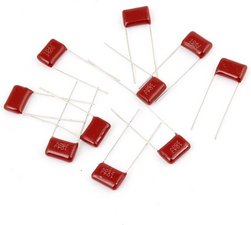@henriko, you mentioned that two of the three speeds work. Is the non-working speed the slowest one?
I'm thinking that capacitor has simply gotten so old that it's not working as well as it should. It's going to take more current to start up the motor at the slower speed, whereas at the higher speeds there's still enough current to turn the motor. The weakened capacitor can't store enough current to drive the motor in its high current demand, but still has enough to run them at lower currents.
I had a similar situation with my air conditioner. The fan wasn't running, but if I turned it on and manually started the blades it would spin up and run fine. Replacing the startup capacitor fixed the problem. If there's a way to do it without risking your fingers, can you try spinning the beater(s) manually and see if they start running on their own?
That is almost certainly a paper capacitor, commonly used in antique radios of that era. In those days, the paper worked fine as long as it wasn't exposed to moisture, which is why they were encased in wax.
From antiqueradio.org:
A paper capacitor may look gooey or melted, yet test OK. Conversely, it may look perfect, but test bad on a capacitor checker. The leakage is internal, caused by water vapor that invisibly penetrates the wax or plastic coating over time, no matter what the exterior looks like. Melted wax is often the result of decades of normal operating temperatures inside the radio.
When repairing antique radios, the first thing that is almost always done is to replace all the paper capacitors, and I see no reason why your vintage mixer should be any different. That last digit on the label is almost certainly "/ 4 A", which really doesn't matter in finding a replacement. Basically you're looking for a 250 V / 0.1 uF capacitor of most any kind except electrolytic. Electrolytic caps are polarized; the have a plus and minus side, where the paper ones don't, so you don't want an electrolytic. Here's an example of a kind that the antique radio buffs prefer.
uxcell 10 PCS 250V 0.1uF 2 Terminals Lead Rectangle Polyester Film Capacitors - - Amazon.com
Hope this helps; let us know how it goes!
crwdns2934105:0crwdne2934105:0
crwdns2934113:0crwdne2934113:0
crwdns2915270:0crwdne2915270:0
crwdns2889612:0crwdne2889612:0
2







 5
5  98
98  1.9crwdns2936485:0crwdne2936485:0
1.9crwdns2936485:0crwdne2936485:0 


crwdns2944067:09crwdne2944067:0
Can you disassemble the mixer and take a picture of the components inside? Adding images to an existing question
crwdns2934271:0crwdnd2934271:0 Andrew S crwdne2934271:0
Thanks Andrew appreciated. Sure, will do soon.
crwdns2934271:0crwdnd2934271:0 Henry crwdne2934271:0
Took pictures and looked for any info inside, found these:
* on the big chunk that looks like a fuse: ...itbandentstörer / ...0,1 uF / 250 VAC 74 A or / 4 A (hard to see some of the info)
* metal case: 0463 45 / EH (?) 52 140W
crwdns2934271:0crwdnd2934271:0 Henry crwdne2934271:0
Can you see the pics? I cannot from here, do they show up?
crwdns2934271:0crwdnd2934271:0 Henry crwdne2934271:0
@henriko On your original question, go to Options>Edit and add this after the question:
[image|2739709]
[image|2739711]
[image|2739710]
[image|2739714]
[image|2739712]
[image|2739713]
In the future, when you want to post images, after you get into the edit menu, go to the end of the text in your question, select the image button, select the upload button, and add your pictues there.
crwdns2934271:0crwdnd2934271:0 Andrew S crwdne2934271:0
crwdns2934275:04crwdne2934275:0